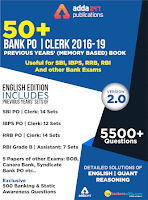Reasoning Questions for SBI PO MAINS 2019
Directions (1-5): Study the following information carefully and answer the questions given below.
Seven persons A, B, C, D, E, F and G of a family having three generations born in seven different years 1969, 1974, 1981, 1985, 1989, 2009 and 2016. (All the ages of the given persons have been calculated on base year 2019 and all the persons are considered to be born on same date of same month).
F is grand-daughter of A. B is 20years younger than A. E is mother of G. C has only two children. E is not married to B. D is older than C. Son of E is 7years younger than E’s daughter. B is son of D and 8years younger than his brother. Mother of G is 4years younger than C. G is not niece of B. A and his sons are born in odd numbered year.
Q1. Who among the following born in 1981?
Q2. How C is related to G?
Q3. What is the age difference between B and G’s mother?
Q4. A was born in which of the following Year?
Q5. Who among the following is grandmother of F?
Directions (6-9): Study the given information and answer the questions:
When a number arrangement machine is given an input line of numbers, it arranges them following a particular rule. The following is an illustration of an input and its rearrangement.
Input: 75 67 42 38 92 56 87
Step I: 225 201 126 114 276 168 261
Step II: 20 2 18 8 54 56 8
Step III: 10 1 9 4 27 28 4
Step IV: 28 27 10 9 4 4 1
Step IV, is the last step of the above arrangement as the intended arrangement is obtained.
As per the rules followed in the given steps find out the appropriate steps for the given input:
Input: 47 69 52 64 93 86 72
Q6. What is the difference between the numbers which is third from the left in step III and the number which is fourth from the right in step IV?
Step 1: All the number(input) multiply by 3.
Step 2: First two digit of the number are added then multiply by third digit.
Step 3: All the numbers divided by 2.
Step 4: All number are arranged in descending order.
Input: 47 69 52 64 93 86 72
Step I: 141 207 156 192 279 258 216
Step II: 5 14 36 20 81 56 18
Step III: 2.5 7 18 10 40.5 28 9
Step IV: 40.5 28 18 10 9 7 2.5
Q7. Which of the following number is third from right in step I?
Step 1: All the number(input) multiply by 3.
Step 2: First two digit of the number are added then multiply by third digit.
Step 3: All the numbers divided by 2.
Step 4: All number are arranged in descending order.
Input: 47 69 52 64 93 86 72
Step I: 141 207 156 192 279 258 216
Step II: 5 14 36 20 81 56 18
Step III: 2.5 7 18 10 40.5 28 9
Step IV: 40.5 28 18 10 9 7 2.5
Q8. What is the sum of digits of the number which is fourth from the left in step II?
Step 1: All the number(input) multiply by 3.
Step 2: First two digit of the number are added then multiply by third digit.
Step 3: All the numbers divided by 2.
Step 4: All number are arranged in descending order.
Input: 47 69 52 64 93 86 72
Step I: 141 207 156 192 279 258 216
Step II: 5 14 36 20 81 56 18
Step III: 2.5 7 18 10 40.5 28 9
Step IV: 40.5 28 18 10 9 7 2.5
Q9. What is the resultant, If smallest number of Step II is multiply by second highest number of step III?
Step 1: All the number(input) multiply by 3.
Step 2: First two digit of the number are added then multiply by third digit.
Step 3: All the numbers divided by 2.
Step 4: All number are arranged in descending order.
Input: 47 69 52 64 93 86 72
Step I: 141 207 156 192 279 258 216
Step II: 5 14 36 20 81 56 18
Step III: 2.5 7 18 10 40.5 28 9
Step IV: 40.5 28 18 10 9 7 2.5
Q10. The economy grew by 4.7 per cent in the quarter ending December, which was slightly better than the average of 4.6 per cent during the first half of the year.
Which of the following assumptions is implicit in the above statement? (An assumption is something supposed or taken for granted.)
Directions (11-15): Study the information carefully and answer the questions given below.
In a certain code language:
“Change Sudden Electric” is coded as “M8# V24# X22*”
“Report Pointed Nature” is coded as “G9# V13* W11*”
“Polity State Optimal” is coded as “V8# B11# O12*”
Q11. What is the code for ‘Assignment’ in the given code language?
Q12. ‘V21*’ can be coded for which of the following?
Q13. What is the code for ‘Horizontal’ in the given code language?
Q14. ‘V13*’ can be coded for which of the following?
Q15. What are the code for ‘Need Optimal Arrangement’ in the given code language?
- Check the Study related Articles Here
- Study Notes for All Banking Exams 2018
- Bankers Adda Daily Questions for SBI PO, IBPS PO Clerk & Bank Exams





 GA Capsule for SBI Clerk Mains 2025, Dow...
GA Capsule for SBI Clerk Mains 2025, Dow...
 The Hindu Review October 2022: Download ...
The Hindu Review October 2022: Download ...
 SBI PO Cut Off 2025, Check Category Wise...
SBI PO Cut Off 2025, Check Category Wise...


